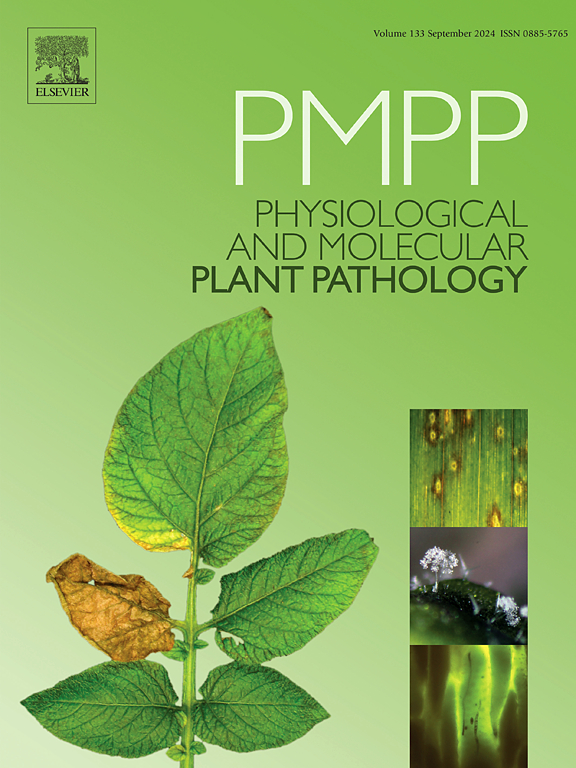互交稻对l -半胱氨酸体外处理响应机制的转录组分析
IF 2.8
3区 农林科学
Q2 PLANT SCIENCES
引用次数: 0
摘要
据报道,l -半胱氨酸(Cys)能显著抑制交替孢霉(Alternaria alternata)的体外生长,破坏其细胞壁和膜的完整性。然而,这种抑制作用的确切机制尚不清楚。为了确定受Cys影响的特定基因和途径,利用RNA测序技术对培养2 d后的花楸转录组谱进行了表征。共鉴定出9982个基因,其中1350个基因在对照和cys处理的样品中表现出差异表达。这些差异表达基因主要富集在跨膜转运蛋白活性、糖酵解代谢、核糖体生物发生以及Cys和还原性谷胱甘肽代谢途径等功能类别中。同时,观察到Cys显著影响戊糖磷酸途径和二羟基苯丙氨酸(DOPA)黑色素合成途径。RT-qPCR分析证实,Cys处理显著上调了AaRio2、AaNob1、AaNop1、AaNmd3、AaLsg1、AaSdo1、AaCDO、AaCSE、AaGCL、AaGS、AaGST和AaGR的相对表达水平,同时下调了AaTYR和AaOAS-TL的相对表达水平。综上所述,Cys处理抑制了交替草的跨膜转运蛋白活性、糖酵解代谢和多巴黑色素合成,从而促进了核糖体的生物生成、戊糖磷酸途径和Cys代谢。这种增强激活了真菌的解毒和防御机制。本文章由计算机程序翻译,如有差异,请以英文原文为准。

Transcriptome analysis of the response mechanism of Alternaria alternata to in vitro L-cysteine treatment
L-cysteine (Cys) has been reported to significantly suppress the in vitro growth of Alternaria alternata and disrupt its cell wall and membrane integrity. However, the precise mechanisms underlying this inhibitory effect remain unclear. To identify the specific genes and pathways influenced by Cys treatment, the transcriptomic profile of A. alternata following 2 d of incubation was characterized using RNA sequencing. A total of 9, 982 genes were identified, of which 1, 350 genes exhibited differential expression between the control and Cys-treated samples. These differentially expressed genes were predominantly enriched in functional categories such as transmembrane transporter activity, glycolysis metabolism, ribosome biogenesis, as well as Cys and reduced gluthathione metabolic pathways. Meanwhile, it was observed that Cys significantly influenced pentose phosphate pathway and dihydroxyphenylalanine (DOPA) melanin synthesis pathways. Furthermore, RT-qPCR analysis confirmed that Cys treatment distinctly up-regulated the relative expression levels of AaRio2, AaNob1, AaNop1, AaNmd3, AaLsg1, AaSdo1, AaCDO, AaCSE, AaGCL, AaGS, AaGST, and AaGR, while simultaneously down-regulating the relative expression levels of AaTYR and AaOAS-TL. Altogether, Cys treatment suppressed transmembrane transporter activity, glycolytic metabolism, and DOPA melanin synthesis in A. alternata, thereby promoting ribosome biogenesis, the pentose phosphate pathway, and Cys metabolism. This enhancement activated the fungal detoxification and defense mechanisms.
求助全文
通过发布文献求助,成功后即可免费获取论文全文。
去求助
来源期刊
CiteScore
4.30
自引率
7.40%
发文量
130
审稿时长
38 days
期刊介绍:
Physiological and Molecular Plant Pathology provides an International forum for original research papers, reviews, and commentaries on all aspects of the molecular biology, biochemistry, physiology, histology and cytology, genetics and evolution of plant-microbe interactions.
Papers on all kinds of infective pathogen, including viruses, prokaryotes, fungi, and nematodes, as well as mutualistic organisms such as Rhizobium and mycorrhyzal fungi, are acceptable as long as they have a bearing on the interaction between pathogen and plant.

 求助内容:
求助内容: 应助结果提醒方式:
应助结果提醒方式:


